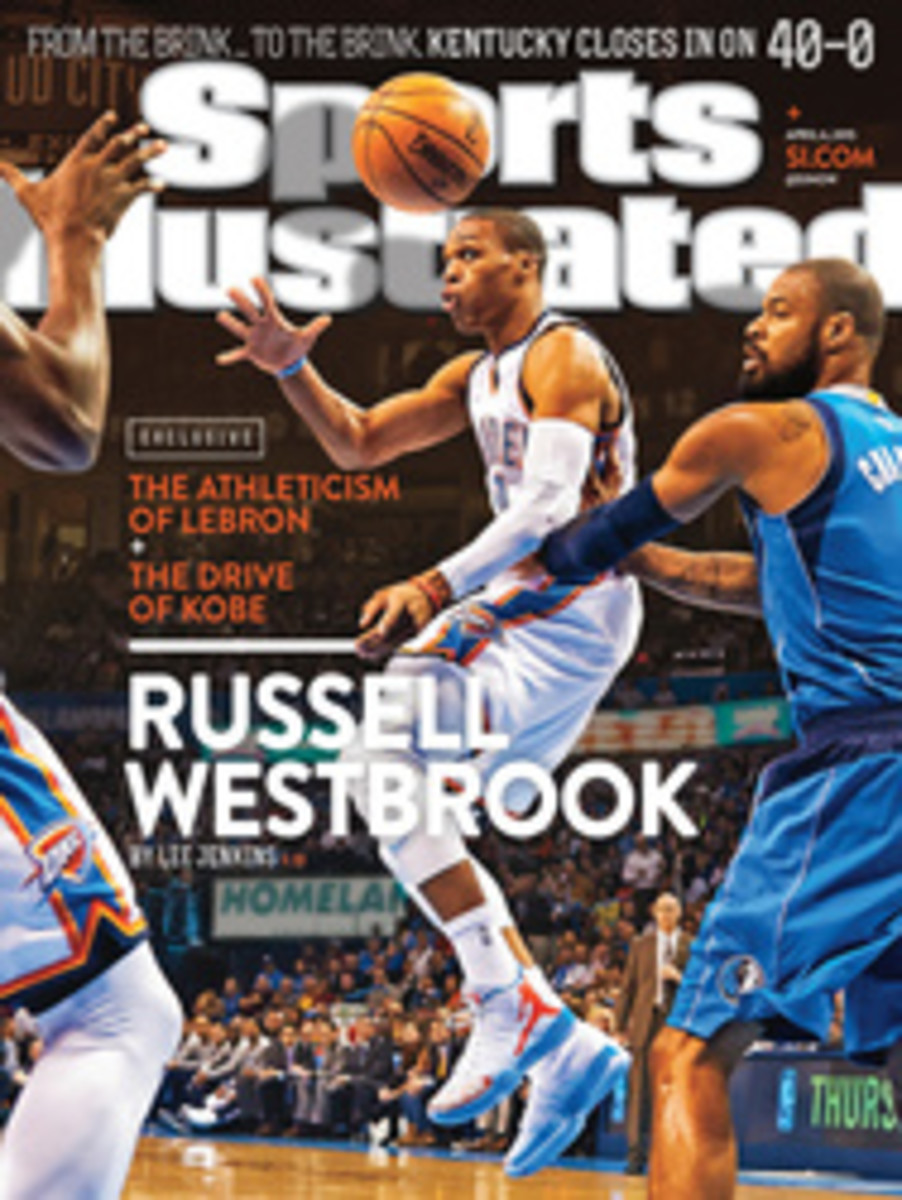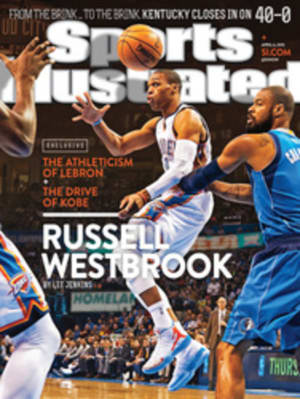
Outpatient Rehab
RECENTLY the oncologist Larry Einhorn sent a letter to each of the hundreds of patients who had once been in his care: As "a personal favor," he asked, would we be willing to return to Indianapolis for a follow-up exam? In an act that nicely capped his life's work, he wanted to collect information about the long-term consequences of a brutal but effective chemotherapy regimen he had long ago devised. If you received one of these letters, you had likely once been a young man struck by testicular cancer.
I was one of those patients. Lance Armstrong was another.
Einhorn, 72, had turned the tables on testicular cancer, making an insidious disease one of the most curable; a personal favor was the least he could ask. In late February, Armstrong and I flew together from Austin to Indianapolis, participants Nos. 198 and 199 in the Platinum Study, named for the key element in the compound Einhorn had seized upon to stymie our cancers.
It had not been a good month for Armstrong: An arbitration panel ruled that he owed $10 million to SCA Promotions—a company that he had sued in 2004 after it had declined to pay him bonuses for winning the Tour de France because of doping suspicions. And he had been forced to cop a guilty plea to plowing into a couple of parked cars in his SUV after his girlfriend initially told police she did it, a reminder, some commentators said, of his manipulative nature.
Those troubles faded in the waiting room at the Indiana University cancer pavilion, where there remains framed Lance Armstrong paraphernalia on the walls: covers from this magazine celebrating his Tour triumphs and a signed jersey. This oncology unit, where Armstrong had once been near death, is one of the last places on earth where the cloud that follows him has failed to cast its shadow.
"How'd you do on the pulse rate?" Armstrong asked as he slid into the chair next to me after the testing had begun.
"Forty-nine." I was pleased—less than 60 is really good. "How'd you do?"
He flashed a grin: "Forty-one."
BEFORE THE flight to Indy I had never met Armstrong in person, but he had helped me in my most desperate moment. Days after I was diagnosed back in January 2006, told at the age of 26 by an emergency room doctor in Austin that the small, hard protrusion in my left testicle was a tumor—"Exactly what Lance Armstrong had, so, you know, some people get this and live"—I unexpectedly got an email from the man himself. He was still very much a hero then, still seeing Sheryl Crow and still the official winner of seven Tours de France. Alerted to my diagnosis by a mutual friend, he sent me a quick pep talk from Johannesburg: "Of course I'm well familiar with what you're going through and am hoping for the best. I'm confident you'll be fine!" He encouraged me to "hang tough and keep livin' strong!" It felt like a Ruthian moment—Ballplayer Visits Sick Kid. Even more critically, he wrote Einhorn's clinic and asked them to squeeze me in.
By means of his chemotherapy regimen, Einhorn had extended our potential, replotting our trajectories from a rapid downward spiral to one where we could imagine a future. On the Tour, Lance, like other riders, had doctored his massive talent, too, extending his natural limits to maintain a competitive edge.
Those victories in France, however they were come by, helped enable the very real victories in cancer wards. There were the hundreds of millions of dollars raised through the Livestrong Foundation, the $3 billion Texas cancer-research referendum he successfully campaigned for, the private emails to lend hope to people like me. And so the rage, the moralizing that followed his confession to Oprah in 2013—FROM HERO TO ZERO crowed one headline—had always mystified me.
"Those of us in the cancer community remember the good he has done," said Einhorn, who is the Lance Armstrong Professor of Medicine at IU. Besides, he seemed to suggest, given the pervasiveness of doping in the sport, the means justified the ends. "You don't do all this good finishing 26th or 27th," Einhorn said.
The way Lance's lie had overshadowed his cancer work irked him. On the flight to Indianapolis, he noted that the media now called him "disgraced cyclist Lance Armstrong." He observed that a recent story about how Roger Clemens was tutoring his college-aged son in pitching failed to describe him as a disgraced baseball player. "And he gave how much back?" Lance asked. And then mouthed the word: Zero. (According to a 2010 New York Times article the Roger Clemens Foundation has raised more than $1 million to aid children's educational and athletic organizations.)
More than anything, Armstrong struck me as both a little restless and a little aimless. He has been deemed radioactive by most charitable organizations—he severed ties with Livestrong to help it survive—and organized competition, even local stuff, is largely closed off to him. "I can't even play table tennis or do archery," he told me. (In March the leader of the International Cycling Union publicly discouraged Armstrong from participating in a charity ride along the Tour route.)
In some ways the head of what was once unofficially known as Lance Inc. seems like any other retired CEO. He occupies his time with one- or two-hour runs (he has not boarded a bicycle since last fall, chiefly because he has to spend three hours atop one to get the same workout), golf and the voracious consumption of magazines, newspapers, TV and movies. He writes letters of support for cancer patients, but he's asked to write far fewer than he once was. He posts his workouts on Strava, a Web community for runners and cyclists, and on the flight to Indianapolis he closely reviewed the comments that had been uploaded. That morning he had run 10 miles at an average pace of 6:47 a mile. ("Ten heavy," he called it, adding, "Throw 'em down and pick 'em up.") Most of the notes were supportive, but he came across one, posted by a guy in Switzerland, that said in part, "Your [sic] not yet done accounting for the past!" He smiled and flicked his middle finger at the screen.
OUR TESTS done, we hurried to the Indianapolis airport to try and grab an earlier flight back to Austin. Only a couple of years ago Armstrong would have had his Gulfstream IV waiting for him on the tarmac. But the plane, like the fancy lakeside mansion in Austin, had been sold off—"I'm trying to cut the burn rate," he told me.
As he attempts to figure out his future, he has one last big case looming: a federal whistle-blower suit based on former teammate Floyd Landis's claims that the U.S. Postal Service team defrauded the government. The Justice Department is reportedly seeking $100 million from Armstrong and other team leaders.
At the gate Armstrong snagged the last standby spot: 16E, a middle seat in coach. I teased him about making friends with his row mates, but he later told me he ended up putting on headphones and watching Whiplash, the Oscar-winning movie about a young drummer whose dreams of success are fired up by a ruthless instructor determined to help his prodigy realize his greatness. I pictured Lance, once among the most famous people on the planet, squeezed between two strangers, his baseball cap pulled low, watching the building intensity of the drummer's training. He no doubt could identify with the kid's competitive spirit, yet Armstrong no longer had an outlet, a drum to bang, a cause to champion.
He texted me once more after he landed: "How much did you weigh on that scale? I thought that s--- was way off."
Asher Price is a reporter with the Austin American-Statesman and the author of Year of the Dunk: A Modest Defiance of Gravity.
"THIS ONCOLOGY UNIT, WHERE ARMSTRONG HAD ONCE BEEN NEAR DEATH, IS ONE OF THE LAST PLACES WHERE THE CLOUD THAT FOLLOWS HIM HAS FAILED TO CAST ITS SHADOW."
SI Edge
Yoga Love
18
Faces in the Crowd
20
Extra Mustard
21
Dan Patrick
Scott Boras
22
The Big Board
Jacob Nix
25
ILLUSTRATION
ILLUSTRATION BY ANDREW DEGRAFF
PHOTO
AJ MAST FOR SPORTS ILLUSTRATED
What's Up, Doc? Armstrong volunteered to participate in a follow-up study with Einhorn (above right) who pioneered the cyclist's treatment.
PHOTO
AJ MAST FOR SPORTS ILLUSTRATED
[See caption above]
PHOTO
AJ MAST FOR SPORTS ILLUSTRATED
[See caption above]

